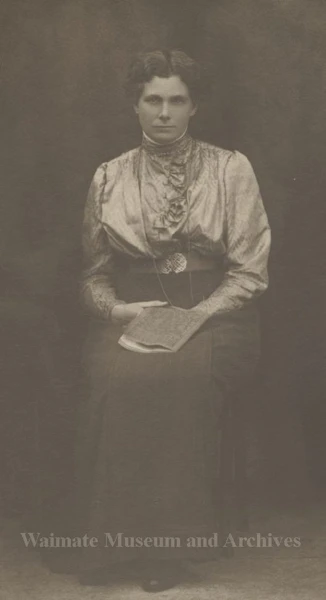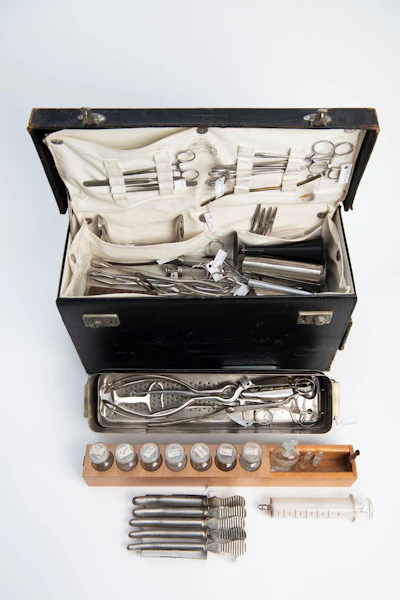by Emeritus Professor of Obstetrics and Gynaecology Peter Stone, University of Auckland, and Bayley Moor, 2025
On display at Northland Medical Museum is the doctor’s bag of Dr Eleanor Baker McLaglan: health camp promoter, house surgeon, rural doctor, and advocate for children’s health.
This leather doctor’s bag and its related contents belonged to Dr Eleanor Baker McLaglan, a remarkable figure in the history of General Practitioners in rural New Zealand. From 1910 McLaglan was a general practitioner in Te Kōpuru, near Dargaville. The contents of her bag reveal the scope of practice that general practitioners especially but not exclusively in rural areas were expected to have.
Sterilisation by boiling
Many of the instruments had to be sterilised by boiling at the point of care, usually in the home or the doctor's surgery immediately prior to use. There was no central sterile supply department available with instruments cleansed, sterilised by heat or gamma radiation, and then packed in impermeable wrappers to be opened at the time of surgery.
This doctor’s bag carried it all: each instrument required for surgery and childbirth, plus various medications, were carefully stowed within. Some of the surgery undertaken was minor, such as lancing boils or removing foreign bodies, but some was what today would be considered major, requiring hospital care such as the removal of tonsils. Even in the 1930s it was not unusual for a family doctor to perform a tonsillectomy in the home.
"A problem male colleagues did not have"
During her long medical career, Dr Eleanor Baker McLaglan frequently had to fight her way through misogyny.
Born on 13 September 1879 on French Farm in Akaroa, McLaglan later attended classes on the farm at her father's boys boarding school. She then spent two years at Otago Girls High School where she passed the matriculation exam.
Eleanor’s parents decided she should train as a doctor, and she graduated from the University of Otago Medical School in 1903 - one of just two female students in her class. To gained further experience with midwifery training, she was required to attend two births; despite training at Dunedin Hospital, she had not attended one - a problem, she suggested, that male colleagues did not have. She completed a licentiate in midwifery at the Coome Lying-in Hospital in Dublin, Ireland and returned to Aotearoa in 1904.
For the next ten years McLaglan had a variety of temporary appointments: at Seacliff and Ashburn Mental Hospitals; Northern Wairoa Hospital; and locum positions with other doctors around the country. About 1910 McLaglan moved to general practice in Te Kōpuru (Northern Wairoa), overcoming many challenges that presented themselves including a lack of finances and ongoing prejudice against female medical practitioners.
Stethoscope and Saddlebags
Rural medicine included perilous operations, night-time callouts, long journeys on horseback, and the many other demands of a country practice. Dr McLaglan was even consulted on the treatment of animals. During the 1913 smallpox epidemic she acted as the agent for the Department of Public Health, vaccinating Māori in settlements around Dargaville: always carrying her doctor’s bag.
She wrote in her 1965 autobiography, Stethoscope and Saddlebags, that the work there was happy and strenuous but was not well paid. “[They were] the most soul satisfying days of my life… I did the best I could for them… But after three years I was more than conscious of being inadequately trained. A vacancy for a house surgeon at Auckland Hospital was advertised. I applied for the position - as a forlorn hope.” Dr McLaglan was appointed amidst furore due to her gender and resigned two months later.
McLaglan then took up an appointment as a School Medical Officer, one of two for the North and South Island. She found rewards in school medicine, noticing significant improvements in health outcomes for children by implementing small changes. These included vast changes in behaviour when tamariki were given much-needed glasses or diagnosed as deaf, and greatly improving the overall health of children once rotten teeth and infected gums were treated.
Unfailing commitment to public health
In the 1920s McLaglan her research published in the New Zealand Medical Journal on an investigation into the incidence of goitre in school children; co-authored with Dr Charles Hercus. McLaglan was also instrumental in the establishment of the New Zealand Medical Women's Association, hosting the first meeting. In the 1930s she became heavily involved in the children's health camps movement. She retired from school medicine in 1940, but WWII created new opportunities for her unfailing commitment to public health. At age 60 she became a house surgeon, first in Melbourne, and later took up a position as a junior registrar in Wellington.
McLaglan’s final post was as second in command at the geriatric hospital at Silverstream, near Wellington. Upon retiring at age 73 she lived in Auckland and wrote her autobiography, Stethoscope and Saddlebags. She died on 20 September 1969.
Doctors' bag on display
On display at Northland Medical Museum is Eleanor Baker McLaglan’s leather doctors' bag and stethoscope, along with the bag’s contents. On the first shelf below the bag at the rear is the tray for sterilising the instruments and in front, an array of apparatus for minor surgery. The second shelf contains equipment for tonsillectomy, tooth removal, bladder catheterisation, and dilatation of the cervix. The lower shelf shows a pair of obstetric forceps within the tray for sterilising these.
Northland Medical Museum was founded by Dr John Swinney FRCA, and is based at the Heritage Park in Maunu, Whangārei. It is home to a wide range of medical memorabilia and health stories from Northland and New Zealand.
This kōrero | story was originally published on the Our Health Journeys e-museum website in March 2025, and is shared on Kōtuia with permission from Our Health Journeys e-museum.



